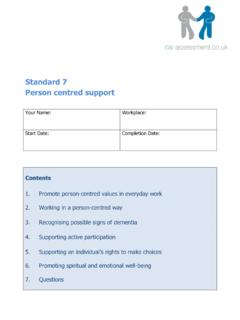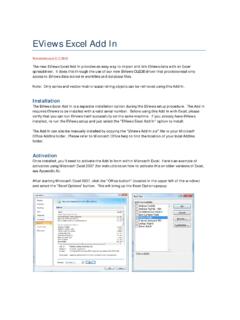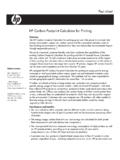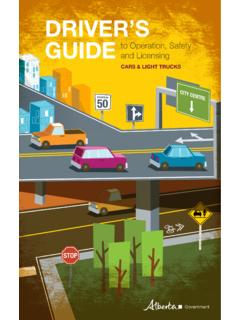Transcription of Standard 4 Equality and inclusion - cis-assessment
1 Standard 4. Equality and inclusion Your Name: Workplace: Start Date: Completion Date: Contents 1. The value and the importance of Equality and inclusion 2. Providing inclusive support 3. Access information, advice and support about Equality and inclusion 4. Questions CIS Assessment Induction workbook Four Standard 4. Equality and inclusion 1. The value and the importance of Equality and inclusion Understand what is meant by diversity and discrimination Diversity means difference. When it is used with Equality , it is about recognising individual as well as group differences, treating people as individuals, and placing positive value on diversity. Diversity is about acknowledging your prejudices, allowing people to be different and respecting these differences.
2 It is also about challenging others if necessary and speaking up for the individuals you support when they cannot speak up for themselves. Discrimination is a preconceived attitude towards members of a particular group formed only upon the basis of their membership of that group that leads to less favourable or bad treatment of that person. The attitude is often resistant to change even in the light of new information. It is essential that you do not allow your prejudices to influence the way you work with individuals. Most people have experienced discrimination in one way or another. Some people are more likely to suffer discrimination. These people might be: older people, young people, females, disabled people, homosexuals, lesbians, transgender people and ethnic minorities.
3 Here are some examples of discrimination: Not employing a married woman because she is likely to take time off work due to pregnancy in the future. A woman with visual and hearing impairments has booked a minicab. The driver asks her to pay the fare in advance, something which he would not require from other passengers. The driver believes, without good reason, that because of her disability she is less likely to be able to pay. A landlord refuses to rent a property to a woman because she is pregnant. A family doctor refers all black patients to a black doctor at the practice, solely because of their colour, not their particular needs. This constitutes direct discrimination on grounds of race.
4 Failing to offer food to take account of cultural differences such as kosher or halal foods. A public building does not provide reasonable access for a person in a wheelchair to be able to access the building in the same way as other people Page 2 of 16. CIS Assessment Induction workbook Four Know how discrimination might occur in your work setting, both deliberately and inadvertently Direct discrimination could take place if individuals are treated less favourably or given a lower Standard of service than other individuals because of their gender, race, ethnicity, culture, disability, religion, sexuality, class, mental health and age. You must be aware of your own prejudices and make absolutely sure that you do not provide a different Standard of care or support to the individuals you are working with.
5 Indirect discrimination could take place when a rule or policy that applies equally to everybody is more restrictive for people from a certain group. For example, if a council only produces information about its homeless applications procedure in English, this puts people whose first language is not English at an unfair disadvantage and could be seen as indirect discrimination. If the council has a good reason for having a particular policy in place (for example, because it's necessary on health or safety grounds) then this won't be indirect racial discrimination. Harassment could be take place because of people's prejudices or because they feel it is acceptable to tease people or tell racist jokes.
6 It creates an unpleasant environment where an individual feels degraded. Victimisation could take place if someone is treated less favourably because they have done something that another person or people do not approve of, for example, they may have made a complaint about a service and they are being treated unfavourably because of this. You have a duty to make sure you understand what might be discrimination and to raise any issues or concerns with your supervisor / manager on behalf of the individuals you support. Understand what is meant by Equality and inclusion , and how they reduce discrimination inclusion is a human right for every individual. The aim of inclusion is to embrace all people irrespective of race, gender, disability, medical or other need, culture, age, religion and sexual orientation.
7 It is about giving equal access and opportunities and getting rid of discrimination and intolerance. inclusion is recognising our universal "oneness" and interdependence. inclusion is recognising that we are "one" even though we are not the "same". The act of inclusion means fighting against exclusion. Fighting for inclusion involves making sure that all support systems are available to those who need support. It is everyone's responsibility to remove the barriers to inclusion . You need to be aware of practices or services in your workplace that could exclude individuals and raise any issues with you supervisor / manager. It might be possible to make changes to reduce the possibility of discrimination from taking place.
8 Page 3 of 16. CIS Assessment Induction workbook Four This is a true story about a fight against discrimination. In 1955 a brave woman in America named Rosa Parks was tired of being denied Equality . She wanted to be fully included in society but this was denied to people labelled as black. Rosa sat down on a bus in a section reserved for white people. When Rosa was told to go to her place at the back of the bus, she refused to move. She was arrested and history was challenged and changed. She had sat down and thereby stood up for inclusion ! Know how practices that support Equality and inclusion reduce the likelihood of discrimination We live in an increasingly diverse society and we need to be able to respond appropriately and sensitively to everyone who we interact with.
9 In providing care and support to individuals this is your duty. The way you approach Equality and inclusion demonstrates whether you are a suitable person to provide care and support One way in which employers have responded to the issue of diversity in recent years has been the development of flexibility in working practices and services. For example, an employer may allow an employee to work a flexible working pattern to accommodate child care arrangements, or a GP surgery may offer surgeries at the weekends in accommodate those who work full time during the week. Therefore, a commitment to Equality in addition to recognition of diversity means that different can be equal.
10 It is important that employers and their representatives behave ethically and lead by example. The UK framework has two elements to it: anti-discriminatory framework gives individuals a route to raise complaints of discrimination around employment and service delivery and public duties which place a proactive duty on employers to address institutional discrimination. Who is protected under the anti-discriminatory framework? Gender Women, men, people who have undergone gender re-assignment. Ethnicity Anyone in relation to ethnic origin, nationality, colour or culture. Disability Anyone with an impairment that has a substantial and long term effect on their ability to carry out day to day activities.











